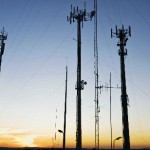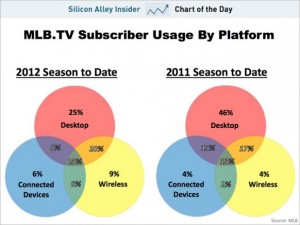We Could End Up Striking Out On Wireless Spectrum
 There’s no doubt fall is a great season for sports fans. With the MLB playoffs and football season around the corner, fantasy drafts, trash-talking and tailgate recipe research is in full swing online. Thanks to technological advances, sports and sports fans have gone mobile as sports enthusiasts, like other consumers, embrace connected devices in just about every aspect of their lives.
There’s no doubt fall is a great season for sports fans. With the MLB playoffs and football season around the corner, fantasy drafts, trash-talking and tailgate recipe research is in full swing online. Thanks to technological advances, sports and sports fans have gone mobile as sports enthusiasts, like other consumers, embrace connected devices in just about every aspect of their lives.
Online video sites such as MLB.TV allow fans to stream every game online. A recent MLB Advanced Media chart shows that from the 2011 to 2012 baseball seasons, online viewership on only desktops fell by almost half, and viewership via a combination of desktops, smartphones, Xboxes and other connected devices nearly doubled. And for many fans that only stream NFL games online, providers  now offer online viewing packages, sending streaming videos of games to mobile devices.
now offer online viewing packages, sending streaming videos of games to mobile devices.
TV ads illustrate the opportunities of wireless technology – sneak a peek at the score while you’re waiting to order dinner, watch your favorite team while you’re on a trip away from home – but as we embrace how technology supports greater connectivity in every aspect of our lives, there is another question at hand: How do all the possibilities in online technology impact the consumer experience?
People are streaming video at an unprecedented rate on an array of devices, creating a surge in wireless data traffic. All indications are that investment in network infrastructure is strong as providers strive to give customers more of what they want. But in order for consumers to enjoy high-quality video without loading bars and interruptions, we need wireless spectrum, the airwaves that carry data over wireless networks. The problem is only a small percentage of available spectrum has been allocated for commercial wireless use.
With skyrocketing consumer demand, the current spectrum supply just won’t meet consumer needs. Spectrum is projected to be maxed out by 2013.
This isn’t an issue that can be allowed to languish in the off-season. The federal government must take immediate steps to release more spectrum for consumer use to better meet their needs. In areas of health care and education, the consequences of not doing so are more serious than a Facebook post touting the winning field goal. 21st century policies must encourage innovation and private investment in our network infrastructure so that consumers can continue to enjoy all of technology’s possibilities today and in the future.








